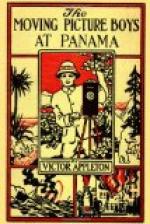The boys and Mr. Alcando saw what seemed to be a procession of green leaves making its way through the jungle.
“Those are real leaves the ants carry,” explained the guide, who spoke very good English. “They are called leaf-cutting ants, and each one of them is really carrying a leaf he has cut from some tree.”
On closer inspection the boys saw that this was so. Each ant carried on its back a triangular leaf, and the odd part, or, rather, one of the odd features, was that the leaf was carried with the thin edge forward, so it would not blow in the wind.
“What do they do with ’em?” asked Joe. “Eat ’em, or make houses of ’em?”
“Neither,” replied the guide. “The ants put the leaves away until they are covered with a fungus growth. It is this fungus that the ants eat, and when it has all been taken from the leaves they are brought out of the ant homes, and a fresh lot of leaves are brought in. These ants are bringing in a fresh lot now, you see.”
“How odd!” exclaimed Blake. “We must get a picture of this, Joe.”
“We sure must!” agreed his chum.
“But how can you take moving pictures of such small things as ants?” asked Mr. Alcando.
“We’ll put on an enlarging lens, and get the camera close to them,” explained Blake, who had had experience in taking several films of this sort for the use of schools and colleges.
A halt was called while the camera was made ready, and then, as the ants went on in their queer procession, carrying the leaves which looked like green sails over their backs, the film clicked on in its indelible impression of them, for the delight of audiences who might see them on the screen, in moving picture theaters from Maine to California.
“Well, that was worth getting,” said Blake, as they put away the camera, and went on again. “I wonder what we’ll see next?”
“Have you any wild beasts in these jungles?” asked Mr. Alcando of the Indian guide.
“Well, not many. We have some deer, though this is not the best time to see them. And once in a while you’ll see a—”
“What’s that?” suddenly interrupted Blake, pointing through the thick growth of trees. “I saw some animal moving then. Maybe it was a deer. I’d like to get a picture of it.”
There was a movement in the underbrush, and a shouting among the native carriers.
“Come on!” cried Joe, dashing ahead with a camera.
“Better wait,” advised Mr. Alcando. “It might be something dangerous.”
“It’s only some tapirs, I think,” the guide said. “They are harmless.”
“Then we’ll film them,” decided Blake, though the mere fact of harm or danger being absent did not influence him.
Both he and Joe had taken pictures of dangerous wild animals in Africa, and had stood at the camera, calmly turning the handle, when it seemed as though death was on its way toward them in horrible form. Had occasion demanded it now they would have gone on and obtained the pictures. But there could be no danger from the tapirs.




